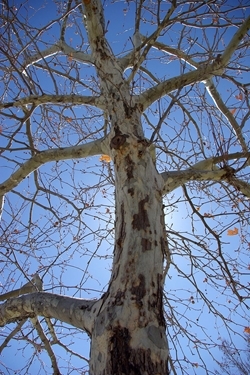London plane tree
 London is culturally an incredibly diverse city, with only around 45% of the population being white British born. But it is not just the human population that is varied in its makeup, as the commonest tree in the city, accounting for over half of all trees, is the London plane, which is also originally a mix of foreign blood – or should I say sap!
London is culturally an incredibly diverse city, with only around 45% of the population being white British born. But it is not just the human population that is varied in its makeup, as the commonest tree in the city, accounting for over half of all trees, is the London plane, which is also originally a mix of foreign blood – or should I say sap!
The London plane is a product of the coming together of two tree species from opposite sides of the globe: the Oriental plane (Platanus orientalis) and the American sycamore (Platanus occidentalis). London plane also sometimes goes by the name of Platanus hispanica, as the hybrid tree was thought to have perhaps originated from Spain, where the hybridisation had first occurred naturally between two imported trees. It appears to have first arrived on our shores in the 17th century.
Once here, the tree became popular and records show that two London plane trees were presented to the Bishop of Lincoln around 1663, and these are both still growing at Buckden Towers in Cambridgeshire, making them over 350 years old. Another tree that still thrives and was also planted around this time was planted by the Bishop of Ely at Ely Palace in 1680.
The tallest London plane in Europe can be found growing at Bryanston School in Dorset, measuring in at 48.5 metres tall, (most recently re-measured in 2008). It lives alongside several others that have reached more than 40 metres in an avenue planted in 1749 to mark the centenary of the execution of Charles I. The tree at Ely, however, has a girth of over nine metres, making it the largest in Britain.
The oldest trees within London are probably those growing in Berkeley Square, thought to have been planted in 1789, making them 220 years old. So how did this hybrid species become known as the London plane tree, especially as it is found all over Europe, Australia and in North and South America?
Well, the tree has many interesting characteristics. Firstly, the khaki camouflage-patterned bark, with its mottled mix of grey, olive and cream, constantly regenerates itself by allowing sections to peel off, meaning that the tree does not collect damaging pollutants on its trunk. The large, thick, quite leathery, maple-shaped leaves also manage to wash themselves clean of dirt every time there is rain, leaving them looking green and fresh. They also turn a colourful golden yellow in autumn.
Add to these traits the fact that the tree does not seem to mind cold winters or hot, dry summers and will grow on any soil type – including badly compacted soils – and you begin to see why it might do well in an urban setting. It also appears quite happy to be pruned or pollarded to keep its size in check!
Once the Industrial Revolution got underway and all Londoners kept warm beside coal fires, the city became blackened with pollutants and soot. However, in amongst all this filth, people soon noticed that the plane tree grew well and stayed refreshingly green amongst all the grime. So the tree was planted throughout the city in great numbers, eventually earning it the name of the “London plane”.
One of the only drawbacks with this tree appears to be when the fruits appear. The London plane is monoecious, meaning the ball-shaped male and female flowers are found on the same tree, although on different stems. After the female flowers have been pollinated with the help of the wind, spiky fruits will eventually appear. These fruits are made up of a dense cluster of seeds with stiff hairs, which will help them to disperse during winter gales. Some people have found that these seeds can induce allergic reactions, ranging from rashes to asthma.
There was a large London plane tree growing in my school grounds and, as mischievous schoolboys, we had great fun with these hairy seeds, as it was common knowledge that when crushed up, they made excellent itching powder – allergies did not seem to be much of an issue in those days! Many a boy had a little sprinkling of the ground-up powder placed in his underpants while he was out playing sport. Once the victim had showered and re-dressed, we would all gather around to enjoy the wonderful Irish jig performance that would undoubtedly follow, often given to such a high standard that even Michael Flatley would have been impressed!
Peter Thompson
Advisory

Download Peter Thompson's essential 26-page book, featuring beautiful photography and detailed profiles of Britain's wildlife
Download FREE >